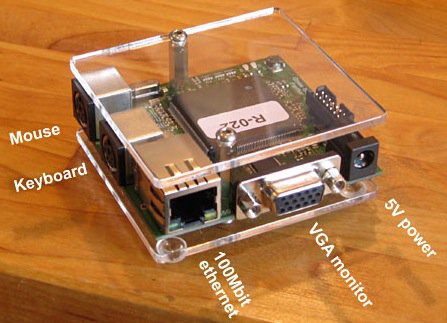Ndiyo
I don’t think I’ve blogged much about where I work, other than perhaps to put the links up to the left there. At Ndiyo we’re dedicated to trying to lower the cost of access to computing for the developing world. Our approach to this is through a modern take on an old solution – thin client computing. Our thin client, called a Nivo, can be connected to a computer over a local area network to provide another terminal on that computer. The nivo has no real processing power, it’s as thin a client as possible – essentially a framebuffer on a chip with a few basic (but fast) graphics operations, all of which are made possible using chips from a local company (started by Ndiyo’s founder) called Display Link. The current generation of Nivos look a little like this:

The idea is that sharing one PC by using multiple Nivos is a lot cheaper than having to get multiple PCs, particularly in parts of the world where a PC can cost the equivelent of a year’s salary. You can use multiple Nivos to add multiple screens to a single Linux based PC. We’ve event got a customised Ubuntu LiveCD to help people get started. So you want a 5 terminal computer system? You just need one PC and 5 Nivos, and away you go. The current generation of Nivos do up to 1280×1024 true colour displays, and are good enough for most modern computing tasks with the exception of gaming, where you really do need a high-end graphics card.
There are other benefits from this approach besides cost too. Managing and maintaining one PC is a lot less trouble than managing multiple PCs – software upgrades, backups, parts replacement etc. only happen at a single point. The Nivos have no state and no moving parts. They’re also more power efficient, using up to 5 watts as a thin client, compared to PCs which use 60+ watts. And in areas where power is unpredicatble you only need to provide UPS systems to the main PC – as the Nivos are stateless if the power drops out and returns then the system just picks up from where it left off.
Currently the technology is fairly stable, and we’re improving it all the time, both in terms of ease of setup (important for a technology to be deployed in far flung parts of the world when there’s only a few of us working at Ndiyo!) and increasing in terms of functionality and performance. At the moment our major stumbling block is price – we make the Nivos in the UK in small batches, so they’re not as cheap as they need to be to make them widely deployable, we need to find orders in the many thousands for that to happen. But for such orders to come in we need to get the kit out there and generate demand – a chicken and egg situation!
But this process has to start somewhere. So now, through Ndiyo’s sister company Cambridge Visual Networks (CamViNe for short), we’re making available an early access Ndiyo Starter Kit – read the Ndiyo announcement on our blog or jump straight to starter kit page at CamViNe. Here interested parties can get a 5 Nivo kit along with our Linux software to driver them in order to evaluate our technology. It’s important to note that the starter kit price represents the cost we need to charge whilst we still make Nivos in small volumes and to cover support costs, rather than the cost we think Nivos should be charged for. Hopefully the kit will help generate that demand we need to make Nivos in large scale that will drive down costs.
We’re very excited by this at Ndiyo, so if you’re interested do drop us a line!
- Next: Mobile coffee bar
- Previous: Silent, blinking death
- Tags: Camvine, Ndiyo, Nivo, Technology